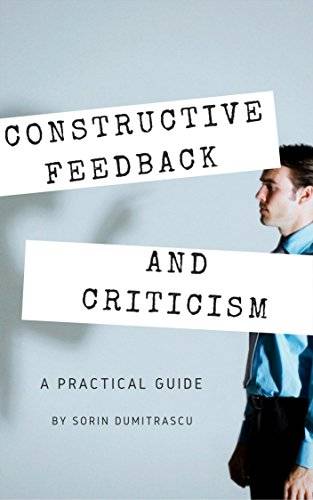

Constructive Feedback and Criticism: A Practical Guide
by Sorin Dumitrascu
Feedback lets employees know how well they're doing at meeting goals and expectations. Used well, it creates a supportive environment, motivates people, helps to maintain or improve performance, and provides people with insight into how others see them and their work.
You use positive feedback to reinforce, support, or encourage positive behavior. You use corrective feedback to help employees improve. To give this feedback, specify what's wrong, keep it relevant, and be supportive.
To give effective feedback, directly observe the person's behavior, without hovering or making judgments until you're certain of the facts, and determine whether positive or corrective feedback is required.
Aim to give feedback in private or to tailor it for a group so that no one will be embarrassed. Also give feedback as soon as possible after the behavior.
When providing feedback, be specific about the behavior, explain its impact, and state what the person should do next to maintain, improve, or change behavior. When giving corrective feedback, start with a positive, then specify what's wrong that needs correcting, and end on a positive note with an eye to the future.
Constructive criticism is considerate of recipients' feelings and contributes to their development by pointing out errors or inefficiencies. It can open lines of communication and foster a cooperative culture in the workplace, resulting in better problem solving.
Conversely, destructive criticism can adversely affect workplace performance and communication, causing low self-esteem and feelings of inadequacy in recipients.
To provide criticism that's constructive, you should follow three steps. First observe the individual's behavior directly and record examples. Then review any assumptions you've made to ensure you're being objective and prepare what you plan to say. Finally, meet the individual in private and give the criticism constructively. To do this, start with a positive, be specific about the behavior that needs to change, remain calm and respect the recipient's feelings, and end with a positive.
You use positive feedback to reinforce, support, or encourage positive behavior. You use corrective feedback to help employees improve. To give this feedback, specify what's wrong, keep it relevant, and be supportive.
To give effective feedback, directly observe the person's behavior, without hovering or making judgments until you're certain of the facts, and determine whether positive or corrective feedback is required.
Aim to give feedback in private or to tailor it for a group so that no one will be embarrassed. Also give feedback as soon as possible after the behavior.
When providing feedback, be specific about the behavior, explain its impact, and state what the person should do next to maintain, improve, or change behavior. When giving corrective feedback, start with a positive, then specify what's wrong that needs correcting, and end on a positive note with an eye to the future.
Constructive criticism is considerate of recipients' feelings and contributes to their development by pointing out errors or inefficiencies. It can open lines of communication and foster a cooperative culture in the workplace, resulting in better problem solving.
Conversely, destructive criticism can adversely affect workplace performance and communication, causing low self-esteem and feelings of inadequacy in recipients.
To provide criticism that's constructive, you should follow three steps. First observe the individual's behavior directly and record examples. Then review any assumptions you've made to ensure you're being objective and prepare what you plan to say. Finally, meet the individual in private and give the criticism constructively. To do this, start with a positive, be specific about the behavior that needs to change, remain calm and respect the recipient's feelings, and end with a positive.

